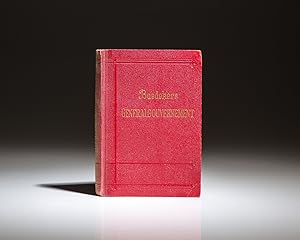BAEDEKER DAS GENERALGOUVERNEMENT (1 resultados)
Tipo de artículo
- Todo tipo de artículos
- Libros (1)
- Revistas y publicaciones
- Cómics
- Partituras
- Arte, grabados y pósters
- Fotografías
- Mapas
-
Manuscritos y
coleccionismo de papel
Condición
- Todo
- Nuevos
- Antiguos o usados
Encuadernación
- Todo
- Tapa dura
- Tapa blanda
Más atributos
- Primera edición
- Firmado
- Sobrecubierta
- Con imágenes del vendedor
- Sin impresión bajo demanda
Ubicación del vendedor
Valoración de los vendedores
-
Das Generalgouvernement Reisenhandbuch; Mit 3 Karten Und 6 Stadtplanen
Publicado por Karl Baedeker, Leipzig, 1943
Librería: The First Edition Rare Books, LLC, Cincinnati, OH, Estados Unidos de America
Original o primera edición
Leather bound. Condición: Very good. Das Generalgouvernement Reisenhandbuch by Karl Baedeker, published in 1943, the travel guide for Nazi occupied Poland and Slovakia during World War II. Ilustrador. First Edition. Twelvemo, lxiv, 264pp. Red leatherette covers, title stamped in gilt on cover. Sunning to spine. Numerous government approval stamps. Includes 6 maps of German occupied cities in Poland, including: Kraków, Lviv [Lemberg], Warsaw [Warschau], Umgebung von Warschau, Lublin, Bad Krynica, Radom, and the country of Slovakia. While not widespread, there were instances of guided tours and visits organized for Nazi officials and citizens to witness and propagate the success of Nazi policies and the establishment of the new order in occupied territories. This book served as a guide on those propaganda tours. The Nazi occupation of Poland during World War II, which began with the German invasion in September 1939, was a period of brutal repression for the Polish people. This occupation, lasting until 1945, was marked by mass executions, forced labor, and the systematic extermination of Jews and other targeted groups in concentration and extermination camps like Auschwitz. Poland became a primary site for the Holocaust, with millions of Jews and others perishing in these camps. The Nazis also sought to destroy Polish culture and identity, closing educational institutions, suppressing religious practices, and executing intellectuals, clergy, and resistance members. The Polish resistance movement, both military and civilian, fought against the occupation, notably during events like the Warsaw Ghetto Uprising and the Warsaw Uprising.


